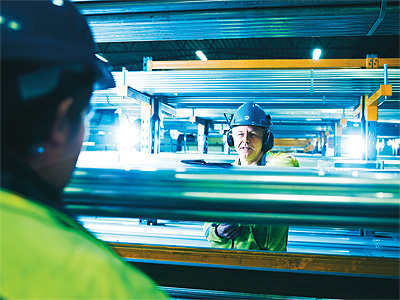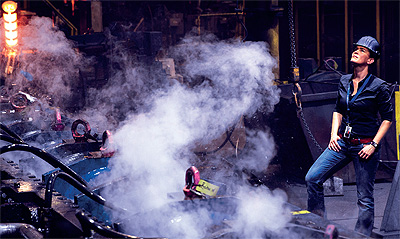Heléns Ror AB
Heléns’ warehouse handles more that 100,000 tonnes of tubing every year for clients within the construction, engineering and processing industries
Focus on the future
Heléns’ warehouse handles more that 100,000 tonnes of tubing every year for clients within the construction, engineering and processing industries
The company was initially founded in 1927, but it was not until the late 1950’s that it received a financial boost, spearheading the company into the successful position it holds today. The purchase of Heléns by the German organisation Benteler has provided a financial strength that was initially very important, and an association that connects the business to engineering clients and industry across many levels.
“That was in essence the change that started us as a tube distributor to the Swedish industries, becoming involved in welded precision steel tubes, seamless precision steel tubes, carbon hollow bars, welded circular hollow sections, special sections, cold formed sections, energy, hydraulics and stainless, selling those products into Sweden,” says Stig Rex, sales director. Since that time the  business has progressively grown from being a traditional stockist, forming closer working relationships with industry, resulting in the investment and development of its own internal production. “Instead of bringing in tubes and logistic services, we started to develop in house production, creating more value for our customers,” he adds.
business has progressively grown from being a traditional stockist, forming closer working relationships with industry, resulting in the investment and development of its own internal production. “Instead of bringing in tubes and logistic services, we started to develop in house production, creating more value for our customers,” he adds.
Belonging to a family owned company, Heléns benefits from a structure that offers quick decisions, and the freedom to control its own destiny, continually delivering results. Today, its processing operation has become a major part of the business, which as Stig points out has been advantageous: “We were quite early to leave the traditional stock business and I think that has been very successful for us.” Expanding from its initial operation in Sweden, its trading envelope encompasses much of the Nordic region such as Finland, Denmark and Norway, as well as the Baltic States and Russia, with local representation and stocks in each area.
The target markets are segmented into three main areas, as Stig highlights: “The biggest segment for us is mechanical engineering, which encompasses the mining industry, the agricultural industry, drilling works, and yellow goods. In general, it has been a very tough year, with significantly less consumption over the last 12 months. However, we are also working very closely with the Swedish automotive industry with manufacturers such as Volvo and Scania, with the car sector having achieved an all time high in 2014. The domestic construction market also maintains a heavy share of our total volume, and we have noticed an improvement in the building sector, with continued strengthening forecast. This has been driven by planned and important investments in infrastructure, and the building of private dwellings for individuals.”
A global reputation has certainly provided the business with an uncompromised strength, and belonging to a group that is active outside of Nordic countries, it too is effectively represented around the world. Working with the likes of Volvo Construction, actively manufacturing big wheel loaders, excavators, haulers, and yellow goods, it is clear the level of respect it has gained in the industry.  Additionally, clients such as Sandvik Mining and Thule place further emphasis on that standing. “One of our major strengths is the mix of products that we have, holding the broadest and deepest stock of tubes for industry, covering all the different types of welded products, seamless tubes, hot rolled bars, and stainless materials, focused strongly on tube solutions for industrial customers.
Additionally, clients such as Sandvik Mining and Thule place further emphasis on that standing. “One of our major strengths is the mix of products that we have, holding the broadest and deepest stock of tubes for industry, covering all the different types of welded products, seamless tubes, hot rolled bars, and stainless materials, focused strongly on tube solutions for industrial customers.
“The in-house production service has also been developed to meet more specific demands, ensuring that the service is delivered in accordance with customer agreements. We have a sales force that is composed of 50 people, with 13 working externally, visiting the customers at sites, and identifying new buyers and new customers. That focus on the customer is essential, and by participating in different exhibitions, we have successfully built a customer stock of close to 2000 buying customers in Sweden,” says Stig.
One problem in high cost countries, such as the Scandinavian market, which has been well voiced, is the little growth in the consumption of steel. The forecast is leveled, and as Stig highlights: “We cannot depend on growth for the future, instead we must depend on ourselves. By increasing the attractiveness of our service, and increasing that drive towards customers and customer solutions, we hope to make the necessary gains.” Since the collapse of the financial market in 2008, the industry has failed to recover to the comfortable levels previously experienced. However, businesses are still active, and competition has increased quite dramatically, particularly with companies from the more heavily affected areas such as Southern Europe, entering the regional market. “This is why it is important that we grow, more in added value, than in volume.
“Having recently reviewed our five-year plan, we work towards the increase of our part of the added value drive, as well as expanding our business with certain products. We are an old and well established organisation, with a high market share for several of our products, so we have to look into the products where we have a lower market share, and review how we can grow on that to increase our volumes, particularly with focusing more on stainless tubes and bars,” concludes Stig.
Heléns Ror AB
Services: Steel tubes